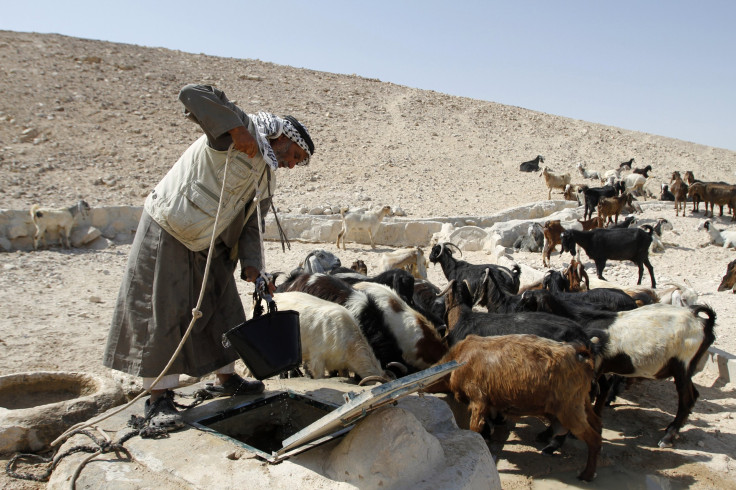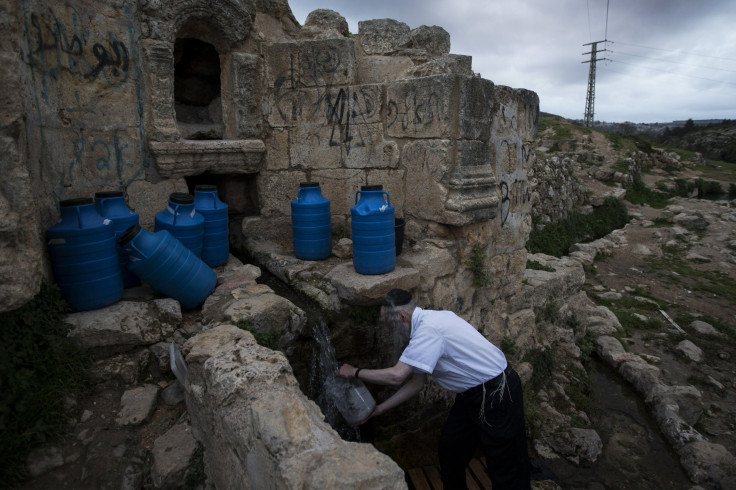World Water Wars: In The West Bank, Water Is Just Another Conflict Issue For Israelis And Palestinians

GHUWEIN AL FAUQA, West Bank -- Traveling along Road 60 as it winds south from Jerusalem into the heart of the West Bank, one sees the hurdles faced by Palestinians as they try to go about their daily lives.
One day in June, as traffic whizzed past Hebron, dozens of schoolchlidren were swarming the road’s narrow shoulders on their afternoon walk home from school. It is dangerous to walk on the edges of this busy road, but the Israeli Civil Administration, which is in charge here as it has been since the 1995 Oslo accords of all land included in the so-called Area C of the West Bank, has never approved a school bus service on this route.
A few hundred meters ahead, firefighters were at work on a grove of recently burned olive trees. All that remained were ashes. Angry Palestinian bystanders claimed that Jewish settlers had set the field on fire.
Skirmishes between Palestinians and settlers, including stone throwing on settlers’ cars, have become a daily routine along Road 60, whose section between the Palestinian municipalities of Bethlehem and Hebron serves at least 75,000 settlers living in an expanding cluster of communities, including Betar Illit, Efrat and Gush Etzion.
Difficult as it is for Jews and Palestinians to share land, it is even more difficult to share the area’s water resources.
This became evident as we travelled a dirt track from the main road to Ghuwein Al Fauqa, a Palestinian village at the southernmost tip of the West Bank.
Sixty people are scattered among makeshift homes of bricks, tin sheets and tarpaulins. Until 2006, 40 households owned fields and grazing lands in the valley below. But that year their land was partially seized by the Israeli government to build the fence which separates the village from Israel.
Since then, military restrictions have made life so difficult that many farmers and herders left the village; now, only nine families remain. Electricity comes from a gasoline-powered generator subsidized by the nearby municipality of As Samu’a. There are no water pipes in the village. Instead, water must be bought from the Israeli national water company, Mekorot, and trucked from a filling station to the village.
According to a report published by the World Bank in 2009, this is the everyday reality for about 10 percent of the more than 2 million people living in the West Bank.
Yellow tankers parked outside the tents are the only source of water for domestic use in Ghuwein Al Fauqa. At a price of 200 shekels per 3.75 cubic meters (roughly $55 per 1,000 gallons), boosted by transportation fees, water does not come cheap for the people of the village.
“We try to save it, by washing clothes every three days, for example, or by feeding the animals the rainwater collected in the cisterns during winter months. But it is never enough,” said Abu Saqer, 51, a herder and father of 10.
With the help of an Italian NGO, Gruppo di Volontariato Civile, and funds from the European Union, five old cisterns have been rehabilitated and a few new ones dug to make the best out of the 20 days (or 200 mm) of rain falling yearly in this dry area bordering the Negev Desert.
For his family and himself, though, Saqer must rely solely on water tankered to the village every eight days. This amounts to 39 liters per day per person (l/d/p), far below the 100 l/d/p considered an optimal supply by the World Health Organization. It’s also expensive for someone who earns an unstable income of 1,000 to 3,000 shekels per month; Saqer said he spends at least 10 percent of his monthly income on water, and up to 50 percent when things are bad.
“Of course we would need more water, and cheaper water, to expand the crops or to set up greenhouses. Unfortunately in summer the municipalities of As Samu’a, Yatta, Dura and Hebron get a bigger share of the water supplied by the Palestinian authorities. So, often I have to buy water from a filling point that is farther away and that costs more, 50 shekels instead of 5 per cubic meter,” said Saqer, sitting on the bare concrete floor next to a dusty, broken TV set.
But his plight is not just the product of Israeli presence on the West Bank, which began with Israel’s victory in the 1967 Six-Day War. “The main reasons for our situation are the Israeli occupation and the poor management of the existing resources by the Palestinian authorities,” Saqer said.

Even Worse In Gaza
Water in the West Bank comes from the so-called Mountain Aquifer, which includes two basins shared with Israel proper, the Northern and the Western, and one entirely included in the West Bank, the Eastern basin. According to the 1995 Oslo II agreement, Palestinians would have the right to draw 118 million cubic meters (mcm) of water from the estimated 679 mcm of water that flow annually into those aquifers. Article 40 of the agreement also established an additional 28.6 mcm to be supplied every year by Israel to the West Bank and Gaza. It quantified as well the “future needs” of Palestinians at 70 to 80 mcm per year, to cope with population growth.
The agreement did not include other water sources the Palestinians would have been entitled to as downstream users, like the Coastal Aquifer or the Jordan River, to which they have no access today. And according to the World Bank, Palestinians in the West Bank have drawn between 117 to 138 mcm from 1995 to 2007, less than the water allocated to them by the Oslo agreements.
As for the Gaza Strip, the emergency has already entered a critical stage, with only 5 percent to 10 percent of the local aquifer now yielding drinking-quality water. Things are not so bad in the West Bank, at least on paper.
“In the West Bank there is no drought, as aquifers are replenished by rainfall. The amount of groundwater would be enough for personal and agricultural needs, if [it was] not controlled by Israel,” said Ayman Daraghmeh, an independent water expert and consultant in Ramallah.
“The Oslo Agreements were supposed to be reviewed after five years within a permanent solution to the conflict, and so the water-sharing arrangement would have been reviewed. It never happened. On top of this, pursuant to the agreements, every water-related project has to be approved by the Joint Water Committee (JWC), and in the case of Area C, also by the Israeli Civil Administration. This mechanism has proved to be an additional constraint,” he added.
The JWC has an equal number of Israeli and Palestinian members and makes decisions by consensus. A report published last year by the University of Sussex analyzed the working documents produced between 1995 and 2008 by the JWC.
According to the report’s findings, the JWC approved no more than 66 percent of Palestinian applications for new wells and approximately 50 percent of those for supply pipes. Projects submitted by Israel for settlements in the West Bank enjoyed 100 percent approval.
While some Palestinian projects might have been rejected on the basis of feasibility or technical faults, the report revealed there may have been a political bias in the JWC’s decisions. For example, whereas 85 percent of Palestinian applications for new productive wells in the Eastern Basin were approved, all similar applications for the Western Basin, which Israel considers critical to its own water security, were rejected.
Israel’s control over water resources is even greater in Area C, which includes Ghuwein Al Fauqa and most of the West Bank. Every project in Area C approved by the JWC must obtain a final permit from the Israeli Civil Administration.
The Politics Of Sewage
According to Ewash, a group of 30 organizations working on water and sanitation in the Palestinian Territories, 59 water structures have been demolished in the West Bank since January 2009, due to a lack of building permits.
“This situation could be improved by treating sewage, but Israelis say they grant permits to new plants only if Palestinians agree also to treat the settlements’ wastewater. But to us it would mean legitimization of the settlers’ presence in the West Bank,” said Jane Hilal, environment unit director at ARIJ, a Palestinian NGO in Bethlehem.
As a result, more than 50 percent of water used in the West Bank by Palestinians is purchased from Mekorot at great cost. Even so, Palestinians enjoy, on average, one-quarter of the water consumed by Jewish settlers and pumped from the same Western Aquifer that should be shared under the Oslo II Agreement.
“We do not expect any water shortage this summer or any problem in the supply, which amounts to 2 mcm per year,” said Davidi Perl, mayor of the Gush Etzion regional council.
Each of the 20,000 residents of Gush Etzion has access to around 273 liters of water per day, seven times the amount available a few kilometers (miles) south to the residents of Ghuwein Al Fauqa.
“I think it is a shame that our Arab neighbors do not have enough water. Every person should have enough to live. But as far as I know they do not pay and so do not get water,” said Mayor Perl.
Indeed, business mismanagement and poor bill collection by Palestinian authorities is acknowledged by several international studies as one of the reasons behind the current water crisis in the West Bank and Gaza.
According to Israel, this is the main, if not the only, reason for the crisis.
“We sit on the same aquifer and we do not want to see it being ruined as it has happened in Gaza because of thousands of illegal drillings. Instead of blaming Israel for everything, the Palestinian authority should treat sewage to obtain 40 mcm per year to use for agriculture. Most importantly, they should fix their water pipes in the urban areas, which have a leaking rate of 33 percent,” said Colonel Grisha Yakubovich, head of the Civil Coordination Department at the Coordination of Government Activities in the Territories (COGAT).
“Many things could be done and should be done, including desalinating seawater, the best resource of all. But come on, Palestinians should take responsibility, that’s all. We can do more, but they can do much more,” Yakubovich said.
COGAT said that at the end of June, Israel would begin supplying an extra 8000 cubic meters of water per day to the Palestinian municipalities of Bethlehem, Hebron, Jenin and Ramallah.
Deemed as a gesture of good will, after lengthy negotiations, this move may actually make the Palestinians even more dependent on Israel’s water supply, instead of expanding their own resources.
Yet, it seems everybody in the West Bank knew that this crisis might be coming, as a consequence of the Oslo peace accords. When faced with the risk of losing any political agreement with Israel because of the disagreement on water, the late Palestinian leader Yasser Arafat decided to give up on water.
He hoped to be able to successfully renegotiate the Oslo accords after five years, as agreed with Israel. It never happened. And almost 20 years later, Palestinians are left with little water and even fewer prospects for peace.
© Copyright IBTimes 2025. All rights reserved.





















